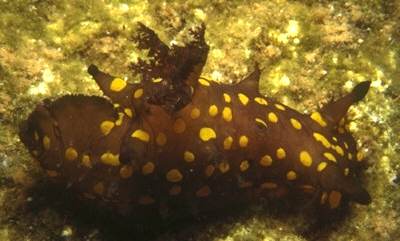
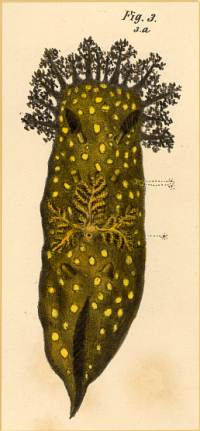
Plocamopherus ocellatus
Rueppell & Leuckart, 1828
Order: NUDIBRANCHIA
Suborder: DORIDINA
Superfamily: ANADORIDOIDEA
Family: Polyceridae
Subfamily: Triophinae
DISTRIBUTION
Red Sea. Also lessepsian immigrant in Mediterranean.
PHOTO
Upper: Kas, Turkey. size: 4-5cm. Depth: 8-10m. August 1998. Photo: Ferda Buyukbayal
Lower: Original painting of Plocamopherus ocellatus. Pl.5, fig. 3a - Rüppell, E. & Leuckart, F.S. (1828)
Originally described from Tor, Egypt, Red Sea, it is recorded below from Turkey, and previously from Israel. This species has seldom been found since its original description. It is the type species of the genus Plocamopherus. It is black with bright yellow spots all over the body. The gills are black with a few small yellow spots, while the rhinophores are completely black. It is similar in general shape to other species of the genus and has a prominent 'keel' or 'caudal fin' in the posterior dorsal midline. It differs from other species of the genus in the nature of the latero-dorsal processes. Usually there are three pairs, and the most posterior pair, at least, are tipped with a large sphere [see Plocamopherus imperialis]. From Rüppell & Leuckart's illustration, and Ferda's photo, there appears to be only two pairs of latero-dorsal processes in P. ocellatus and these are elongately conical in shape.
Reference:
• Rüppell, E. & Leuckart, F.S. (1828) Neue wirbellose Thiere des Rothen Meeres. Atlas zu der Reise im nördlichen Afrika von Eduard Rüppell. Brunner, Frankfurt am Main. 1-22, pls 1-6 pages.
Rudman, W.B., 2002 (November 26) Plocamopherus ocellatus Rueppell & Leuckart, 1828 . [In] Sea Slug Forum. Australian Museum, Sydney. Available from http://www.seaslugforum.net/find/plococel
Related messages
Plocamopherus ocellatus from Iran [2]
May 4, 2010
From: Mahdi Moradi Och Tape

During my researches on Coral Reef in Persian Gulf I found this species on coral Reef bed in Larak & Qeshm Island, and I need your guidance concerning its identification and biology?
Locality: Qeshm Island- Bandar Abbas, 20 February 2007, Iran, Persian Gulf , 2.5 m, coral Reef and rocky bed . Length: 3-4 cm . Photographer: Mohammad Sharif Ranjbar.
Best Regards
Mahdi Moradi
biologymoradi@gmail.com
Moradi, M., 2010 (May 4) Plocamopherus ocellatus from Iran [2]. [Message in] Sea Slug Forum. Australian Museum, Sydney. Available from http://www.seaslugforum.net/find/23602
Dear Mahdi,
This is also Plocamopherus ocellatus [see earlier message #23601]. Its uniform black background colour would appear to be the more usual colour for this species but we still have much to learn about it. It is possible the egg ribbon also belongs to this species but we would need direct evidence - perhaps a photo? - of an animal actually laying the egg ribbon to be sure.
Species of Plocamopherus feed on branching bryozoans, so it is possible the branching sea weed-like growths it is crawling on are its food bryozoan.
Best wishes,
Bill Rudman
Plocamopherus ocellatus from Iran [1]
May 4, 2010
From: Mahdi Moradi Och Tapeh
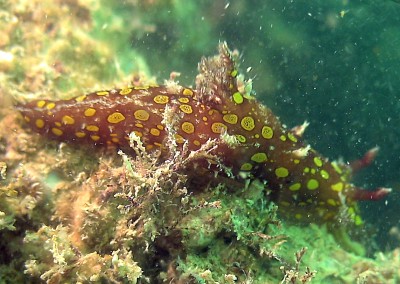
During my researches on Coral Reef in Persian Gulf I found this species on coral Reef bed in Larak & Qeshm Island, and I need your guidance concerning its identification and biology?
Locality: Qeshm Island - Bandar Abbas, 2-5m, Iran , Persian Gulf , 4 February 2009, coral reef and rocky bed . Length: 2-4cm. Photographer: Mohammad Sharif Ranjbar .
Best Regards
Mahdi Moradi
biologymoradi@gmail.com
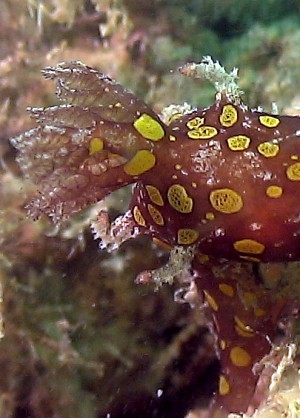

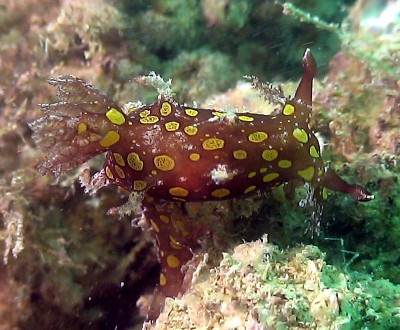
Dear Mahdi,
This is Plocamopherus ocellatus. This rarely reported species was one of the earliest species described from the Indian Ocean. It was first found in the Red Sea and named in 1828. Since then there have been few reported sightings. Strangely, we only have records on the Forum of animals reported from Mediterranean waters [see Lessepsian migration]. Your photos are our first record from the Indian Ocean.
In some species of Plocamopherus [see P. ceylonicus] the large papillae on each side of the body have a large rounded tip - often pink or brown - which luminesces when the animal is startled. I have included a close-up showing a similar tip in your animals - though not has swollen.
I have also added a close-up showing a Y - shaped mark on the back behind the gills. This is equivalent to the edge of the mantle skirt found in many dorid nudibranchs.
Best wishes,
Bill Rudman
Plocamopherus ocellatus from Israel
October 21, 2003
From: Michael Levin
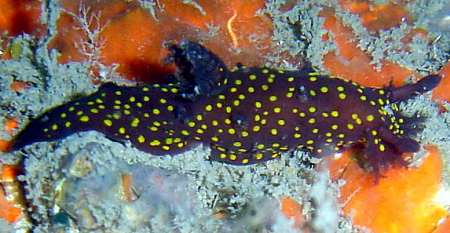

Hi Bill,
I photographed these nudibranchs - Plocamopherus ocellatus at the depth 27 meter as there were crawling on the ship wreck called Ze'ev Hayam in the Mediterranean Sea in front of the city Jaffa (south of Tel-Aviv, Israel).
There were many of them (I saw at least six of them), size about 5-6 cm each.
Best Regards,
Michael Levin
www.pbase.com/manta_ray/nudibranch
michael@scubadiving.com
Levin, M., 2003 (Oct 21) Plocamopherus ocellatus from Israel. [Message in] Sea Slug Forum. Australian Museum, Sydney. Available from http://www.seaslugforum.net/find/11278Thanks Michael,
This is a nice find. There are very few records of this very distinctive species since its first description almost 200 years ago from the Red Sea [Rüppell & Leuckart, 1828]. The 3 or 4 subsequent finds have all been in the Mediterranean where it has apparently migrated since the opening of the Suez Canal
Best wishes
Bill Rudman
Plocamopherus ocellatus from Israel
December 11, 2002
From: Bill Rudman
Concerning the presence of Plocamopherus ocellatus in the Mediterraean, I have found an earlier record from Israel (Barash & Danin, 1982).
• Barash, A. and Danin, Z., 1982. Mediterranean Mollusca of Israel and Sinai: composition and distribution. Israel Journal of Zoology, 31: 86-118.
• Barash, A. & Danin, Z., 1992. Fauna Palaestina: Mollusca I. Annotated list of Mediterranean molluscs of Israel and Sinai. The Israel Academy of Sciences and Humanities, Jerusalem, 405 p. + 372 figs.
Best wishes,
Bill Rudman
Re: Plocamopherus ocellatus from Turkey
November 28, 2002
From: Angel Valdes
Dear Bill,
Jose Templado and I have just published a short paper on some Indo-Pacific nudibranchs from Lebanon, and it includes records of Plocamopherus ocellatus Rüppell and Leuckart, 1830, Hypselodoris infucata (Rüppell and Leuckart, 1830) and Discodoris lilacina (Gould, 1852).
The reference is:
• Valdés, A. & Templado, J. 2002. Indo-Pacific dorid nudibranchs collected in Lebanon (eastern Mediterranean). Iberus.
Angel Valdes
avaldes@nhm.org
Thanks Angel,
I look forward to seeing it. I think H. infucata is now considered a fairly permanent Mediterranean resident and D. lilacina [as D. fragilis] has certainly been reported from their before.
Cheers,
Bill Rudman
Plocamopherus ocellatus from Turkey
November 27, 2002
From: Erwin Koehler

Dear Bill,
This mystery is from Kas, Turkey. The photo was taken by Ferda Buyukbaykal [ferdabbaykal@isnet.net.tr]. I've asked some experts on the Mediterranean fauna, but they don't know this one. Hopefully somebody else has a name for it!
Size: 4-5cm. Depth: 8-10m. August 1998
Erwin
erwin@medslugs.de
Koehler, E., 2002 (Nov 27) Plocamopherus ocellatus from Turkey. [Message in] Sea Slug Forum. Australian Museum, Sydney. Available from http://www.seaslugforum.net/find/8516
FIGURE: Original painting of Plocamopherus ocellatus. Pl.5, fig. 3a - Rüppell, E. & Leuckart, F.S. (1828)
Dear Erwin & Ferda,
This is a very interesting find. As you will see from the painting I have copied alongside there is no doubt that this animal is Plocamopherus ocellatus which was described from the Red Sea [Tor, Egypt] nearly 200 years ago, and has been seldom seen since. I know of only one specimen being found there in the last 30 years. So not only is this an exciting find of a long-lost species, but it is also a new lessepsian migrant into the Mediterranean.
• Rüppell, E. & Leuckart, F.S. (1828) Neue wirbellose Thiere des Rothen Meeres. Atlas zu der Reise im nördlichen Afrika von Eduard Rüppell. Brunner, Frankfurt am Main. 1-22, pls 1-6 pages.
Best wishes,
Bill Rudman
